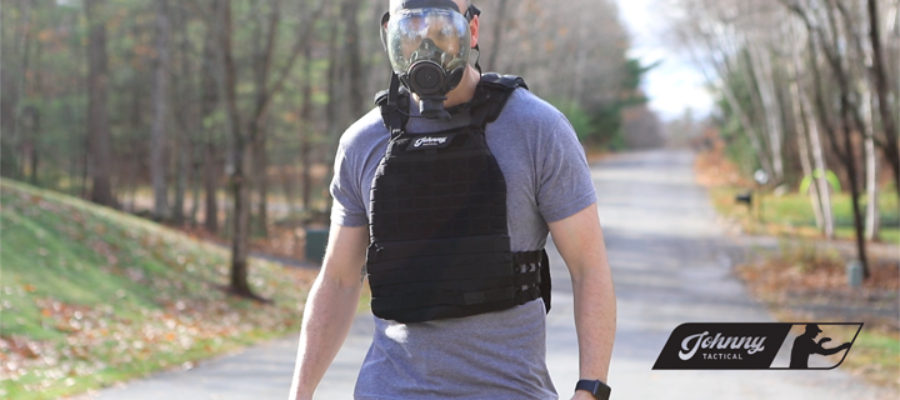I walked past the Spring 2020 edition of The Tactical Edge at work and had to pick it up. The eye-catching cover featuring some high-octane, high-protein SWAT guys wearing gas masks and lugging weights around touched me at my tactical core.
After peeling the cover back and sliding my finger down the index to find out what it was all about, I turned to the featured article outlining the SWAT PFQ — or Physical Fitness Qualification for you non-abreviators. The National Tactical Officers Association (NTOA) put a bunch of tactical and fitness gurus in a room, locked the door, and fed them raw meat and protein shakes through a small hatch until they created a standardized fitness test for SWAT teams.
The Problem
The problem they were trying to solve was that SWAT teams all over the country pretty much do whatever they want for PT tests. Some teams think they’re Navy SEALs and run around carrying telephone poles in the local sandpit while others just drink beer, tell war stories, and measure their guns.
I have been on two different SWAT teams and I can tell you from experience that both teams, even though they were in the same state, had two very different PT tests. If there was no standard even in the same state, then I’m sure the variations found nationwide must be incredible.
The Solution
So, after an undisclosed amount of time, blood, sweat, and protein farts, the gurus emerged from the darkened chamber like Lazarus rising from the dead and the SWAT PFQ was born. The NTOA published the test and asked SWAT teams around the country to run their teams through the PFQ and report back with their results. I figured I’d give it a try and record my results for all of posterity.
The Experiment
Just to give you an idea of where I’m coming from you should know I did no workup or specific preparation before the test. I ran it cold. Even though I try to stay in shape, I’m certainly not the biggest, the strongest, or the fastest. My workouts are a Crossfit-esque type workout, though I’ve just been doing heavy lifts as of late. I haven’t been running or doing any workouts in a gas mask. For my experiment I ran through the test two different times 10 days apart, and recorded the suffer-fest in a lame effort to make a YouTube video for your benefit and entertainment.
The Nitty-Gritty
I’m 42 years old, 6’01” and about 195 pounds. I wore a Johnny Tactical t-shirt, Under Armor BDUs, and Salomon Speedcross trail-running shoes. (I know you’re curious, by my underwear preference will remain a secret). The plate carrier I wore weighed in at 19.8 pounds. The gas mask had no filter.
Here are my results:
Test 1
800m Run – 4:25
400m Run – 3:18
Burpees – 30
Squats – 79
Pull-ups – 12 (all strict)
Test 2
800m Run – 4:04
400m Run – 3:04
Burpees – 32
Squats – 77
Pull-ups – 13 (all strict)
As you can see, I failed the burpees both times. Burpees are my nemesis. I hate them and they hate me, … but I digress.
Here’s my take on the PFQ:
The Pros
The test is simple, but not easy. It’s a surefire gut-check that will expose fitness deficits on your team. It is certainly applicable to SWAT teams since it involves lugging heavy crap in kit over short distances which requires bursts of strength and stamina. The other thing I like about the PFQ is that it’s the same for everyone — male and female, old, and young, bald and those who wish they were bald. After all, everyone is required to do the same job on an operation, so why not on the PT test? After all, firearms qualifications don’t have sliding scales. Imagine if females and old guys could drop rounds, shoot hostages, and it was totally fine. It’s a no-brainer.
The Cons
I don’t think there are any drawbacks to this test. The only things I can foresee is how transitioning to the PFQ will be received by the team. Here’s why: The old bucks and the posers won’t like it — at least the ones that have been squeaking by or having their numbers fudged or a blind eye turned to that last pull-up that they couldn’t get their chin over the bar while they struggled and kicked like a hanging victim on the gallows. The gazelles among the group — the distance runners — and the ones that keep skipping leg day may not like it and will have trouble with it. As for scoring, if you fail one area you fail it all, so I don’t really see the purpose of having bonus points unless it’s just there to pump up the egos of the hardos on the team.
Also, this is America. Change the distances from meters to miles. Enough said.
Conclusion
I think the PFQ is an easy to implement, all-purpose test that is applicable to the physical demands faced by SWAT teams on actual operations. Even though I failed the burpees, I was within striking distance and believe that with some preparation, the test would certainly be achievable.
Side note: I think all PT tests for SWAT teams should be done at a minimum of twice a year.
Watch the video, try the PFQ, record your results, and let me know what you think.
_______________________________
Thanks for reading! Do you have a story that you think we could learn from and that you’d like to share with Johnny Tactical nation? Fill out the contact form and include your name, rank, and department, or email it to [email protected] and follow these guidelines:
- It must be a firsthand account
- True
- Have a lesson, principle, or tactic to apply
- Cleaned of names, dates, and places
- Include your call sign
If your story is selected and published in our blog you’ll get the credit using your call sign and we’ll send you a free Johnny Tactical sticker.






Leave a Reply
Your email is safe with us.
You must be logged in to post a comment.